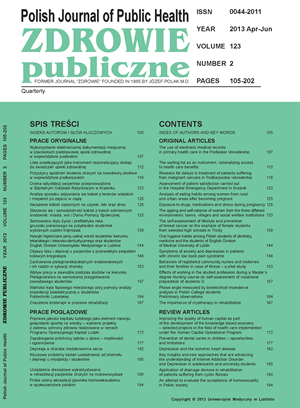Prevention of dental caries in children – opportunities and limitations
DOI:
https://doi.org/10.12923/j.0044-2011/123-2/a.16Keywords:
children, dental caries, caries prophylaxis, prophylaxis strategies, caries risk, individual prophykaxisAbstract
According to the results of epidemiological study – “Monitoring Zdrowia Jamy Ustnej” (Monitoring of Oral Health), Poland belongs to the countries of persistent high prevalence and intensity of caries disease. Caries lesions appear in early childhood and occur in over 50% of children of the age of 3 and in over 80% of children of 12. The analysis of basic determinants of planning prophylactic activity and strategy proposal of prevention against caries disease in children and adolescents is very important.
The paper discusses etiologic factors of caries disease directly and indirectly connected with the development of the disease process. The authors point to the relationship between the occurrence of early childhood caries and colonization time of oral cavity by cariogenic germs and present the relationship between caries in deciduous and permanent teeth. The authors emphasize the necessity of early prophylactic activity already in fetal period (primary primal prophylaxis) and the importance of long-term prophylaxis. Prophylactic strategies are discussed: population and corporate strategies based on the assessment of caries risk.
Attention has been paid to the advantages and disadvantages of prophylactic strategies from Public Health point of view. Epidemiologic data are presented indicating the necessity of combining prevention in population with high prophylaxis and individual risk prophylaxis carried out by dentists. The principles of individual caries prophylaxis and methods of proceeding recommended for patients with risk assessed as low, moderate and high are discusse
References
1. Bromblik A, Wierzbicka M, Szatko F. Wpływ uwarunkowań środowiskowych na zapadalność i przebieg próchnicy zębów u dzieci. Czas Stomatol. 2010;63(5):301-9.
2. Wyniki badań epidemiologicznych prowadzonych w ramach programu „Monitoring Zdrowia Jamy Ustnej” w 2010 roku. http://www.mz.gov.pl/wwwfiles/ma_struktura/docs/wynik_bada_mat_26102011.pdf
3. Wyniki badań epidemiologicznych prowadzonych w ramach programu „Monitoring Zdrowia Jamy Ustnej” w 2011 roku. http://www.mz.gov.pl/wwwfiles/ma_struktura/docs/monitoring_ju_29052012.pdf.
4. Li Y, Wang W. Predicting caries in permanent teeth from caries in pri¬mary teeth: an eight-year cohort study. J Dent Res. 2002;81:561-6.
5. Skeie MS, Raadal M, Strand GV, et al. The relationship between caries in the primary dentition at 5 years of age and permanent dentition at 10 years of age – a longitudinal study. Int J Paediatr Dent. 2006;16(3):152-60.
6. Motohashi M, Yamada H, Genkai F, et al. vEmploying dmft score as a risk predictor for caries development in the permanent teeth in Japa¬nese primary school girls. J Oral Csie. 2006;48(4):233-7.
7. Fejerskov O. Changing Paradigms in Concepts on Dental Caries: Conse¬quences for Oral Health Care. Caries Res. 2004;38:182-91.
8. Meyer K, Geurtsen W, Günay H. An early oral health care program start¬ing during pregnancy: results of a prospective clinical long-term study. Clin Oral Investig. 2010;14(3):257-64.
9. Fisher-Owens SA, Gansky SA, Platt LJ, et al. Influences on Children’s Oral Health: A Conceptual Model. Pediatrics. 2007;120;e510. DOI: 10.1542/peds.2006-3084.
10. Batchelor PA, Sheiham A. The distribution of burden of dental caries in schoolchildren: a critique of the high-risk caries prevention strategy for populations. BMC Oral Health 2006;6:3. doi:10.1186/1472-6831-6-3.
11. Burt BA. Concepts of risk in dental public health. Community Dent Oral Epidemiol. 2005;33:240-7.
12. Watt RG. Strategies and approaches in oral disease prevention and health promotion. Bull World Health Organ. 2005;83(9). http://dx.doi.org/10.1590/S0042-96862005000900018.
13. Pienihäkkinen K, Jokela J, Alanen P. Risk-based early prevention in comparison with routine prevention of dental caries: A 7-year follow-up of a controlled clinical trial; clinical and economic aspects. BMC Oral Health. 2005;5:2. doi: 101186/1472-6831-5-2.
14. Hausen H, Kärkkäinen S, Seppä L. Application of the high-risk strategy to control dental caries. Community Dent Oral Epidemiol. 2002;28(1):26-34.
15. Featherstone JD. The caries balance: The basis for caries management by risk assessment. Oral Health Prev Dent. 2004;2(suppl. 1):259-64.
16. Fisher J, Glick M. A new model for caries classification and man¬agement: The FDI World Dental Federation Caries Matrix. JADA. 2012;143(6):546-51.
17. Prevention and Management of Dental Caries in Children, Dental Clini¬cal Guidance 2010.www.sdcep.org.uk/index.aspx?o=2332


